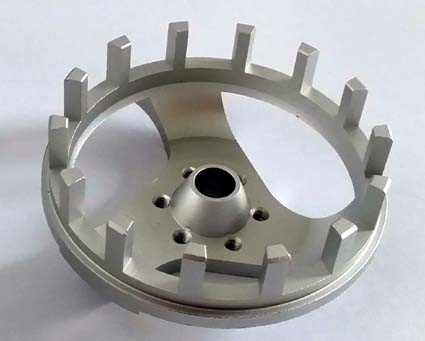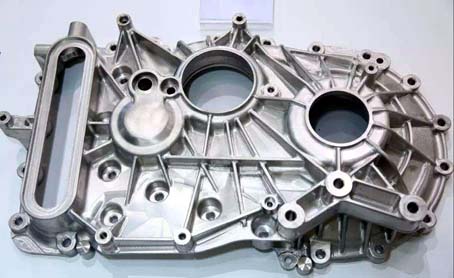Motor Base Type And NC Machining Control Requirements
The motor base is the key component of the motor. The rationality of its structure and processing technology have great influence on the performance of the motor. The unsuitability of the motor's broom, low-frequency electromagnetic sound, vibration, etc. is mostly related to the machining of the machine base. Therefore, the structure of the base should be reasonably selected in accordance with the performance requirements of the motor and processed according to the technical requirements to reduce and eliminate the non-conformity caused by the machining of the base. Today, we will sort out the types of motor stands and some of the most basic technical requirements and share them with you.
 Basic type of motor base
Basic type of motor base
● According to whether the base is magnetic or not, it can be divided into magnetic and non-magnetic magnetic bases. The magnetic base is used for DC motors and pivot-type synchronous motors. Non-magnetic housings are used in asynchronous motors, rotary synchronous motors and other motors with laminated stator cores.
● According to the different blanks of the base, it can be divided into welding and casting bases. The welding base is welded from steel. The casting base can be cast in cast steel, cast iron or aluminum alloy; The magnetically permeable stand is almost always welded with steel or steel.
● Non-magnetic motor housings are generally made of gray cast iron. The cast iron motor base has low cost and convenient processing, and its mechanical strength can meet the requirements of general small and medium-sized motors. High-strength cast iron or cast steel motor seats are used only in applications where high mechanical strength is required, such as explosion-proof motors and marine motors.
● Small AC motors and micro motors. In recent years, aluminum-silicon alloys or aluminum-magnesium alloys have been used to die-cast motor seats. The structure is characterized in that the aluminum alloy can be directly cast on the stator core, the inner circle of the motor seat does not have to be processed, some fasteners are omitted, and the small motor can be made lighter. The disadvantage is that the material price of the aluminum alloy is relatively high, the mechanical strength is weak, and the wear resistance is poor.

● For large motors, because of the small output and the large weight of the motor, the welded seats of section steel and steel plate have been widely used. Compared to cast iron stands, the weight of the welded base is lighter under the same mechanical strength and structural rigidity. When welding, no special mold is required, and the cost is relatively low, the production cycle can be shortened, and the individual shape of the motor can be satisfied.
● According to the structure of the base, it can be divided into an integral frame and a separate frame. The structural rigidity of the separate frame is weak, and the processing time is more. If the assembly is improper, the whole machine will not meet the requirements. However, its unique advantages are convenient installation and maintenance. When the design is reasonable, the assembly accuracy and structural rigidity are no longer the constraints.
The integral motor base is relatively more used, and the section is generally designed to be cylindrical. There are two or four feet in the lower part of the motor base, and the power supply is installed. The cylindrical motor base has the best processability. However, for some motors, when the external dimensions are limited by certain conditions and the power is required to be as high as possible, the cross section of the motor base is often designed as a polygon to make full use of the spatial position. Polygonal motor mounts are more complex to manufacture and processing costs are also increased.
● Other classification methods.
According to the different protection and cooling methods, the motor seat can be divided into open type, protective type, closed type and explosion-proof type. The outer surface of the enclosed and explosion-proof motor base usually has a heat sink, while the other motor bases do not have a heat sink. According to the presence or absence of feet, it can be divided into motor bases with feet (such as B3 and B35) and without feet (such as V1 and B5).
Motor base processing technical requirements

The parts to be machined by the motor base mainly include the end stops, the end faces, the inner circle, the foot plane, the bottom hole, the fixed end cover, the outlet box and the bolts for lifting. For the separation type, the machine base also needs to process the split surface, the screw hole and the pin hole. The technical requirements that should be met during machining of the base can be summarized as follows.
● The dimensional accuracy and roughness of each processing part should conform to the drawings. The accuracy and roughness requirements of the two end stops and the inner circle are both high, and the center high dimensional accuracy is also accurate.
● The geometrical tolerances of each processing surface shall comply with the drawings. The coaxiality between the two ends of the stop and the inner circle, and the end face circular jump of the two ends facing the axis line are the key to the machining of the base. With particular emphasis on: If the geometric tolerance is not specified, the maximum and minimum values shall be within the dimensional tolerance; The foot plane should be parallel to the axis of the shaft.
● The distance between the foot hole and the center line of the base should be symmetrical and meet the specified tolerances.
● After the magnetic machine base is machined, the thickness of each part of the yoke should be uniform. The poles of the poles should be equal and their position must comply with the drawings.
●The split surface of the separate frame requires stable joint and reliable positioning, and can still meet the original requirements when reassembled.

● According to whether the base is magnetic or not, it can be divided into magnetic and non-magnetic magnetic bases. The magnetic base is used for DC motors and pivot-type synchronous motors. Non-magnetic housings are used in asynchronous motors, rotary synchronous motors and other motors with laminated stator cores.
● According to the different blanks of the base, it can be divided into welding and casting bases. The welding base is welded from steel. The casting base can be cast in cast steel, cast iron or aluminum alloy; The magnetically permeable stand is almost always welded with steel or steel.
● Non-magnetic motor housings are generally made of gray cast iron. The cast iron motor base has low cost and convenient processing, and its mechanical strength can meet the requirements of general small and medium-sized motors. High-strength cast iron or cast steel motor seats are used only in applications where high mechanical strength is required, such as explosion-proof motors and marine motors.
● Small AC motors and micro motors. In recent years, aluminum-silicon alloys or aluminum-magnesium alloys have been used to die-cast motor seats. The structure is characterized in that the aluminum alloy can be directly cast on the stator core, the inner circle of the motor seat does not have to be processed, some fasteners are omitted, and the small motor can be made lighter. The disadvantage is that the material price of the aluminum alloy is relatively high, the mechanical strength is weak, and the wear resistance is poor.

● For large motors, because of the small output and the large weight of the motor, the welded seats of section steel and steel plate have been widely used. Compared to cast iron stands, the weight of the welded base is lighter under the same mechanical strength and structural rigidity. When welding, no special mold is required, and the cost is relatively low, the production cycle can be shortened, and the individual shape of the motor can be satisfied.
● According to the structure of the base, it can be divided into an integral frame and a separate frame. The structural rigidity of the separate frame is weak, and the processing time is more. If the assembly is improper, the whole machine will not meet the requirements. However, its unique advantages are convenient installation and maintenance. When the design is reasonable, the assembly accuracy and structural rigidity are no longer the constraints.
The integral motor base is relatively more used, and the section is generally designed to be cylindrical. There are two or four feet in the lower part of the motor base, and the power supply is installed. The cylindrical motor base has the best processability. However, for some motors, when the external dimensions are limited by certain conditions and the power is required to be as high as possible, the cross section of the motor base is often designed as a polygon to make full use of the spatial position. Polygonal motor mounts are more complex to manufacture and processing costs are also increased.
● Other classification methods.
According to the different protection and cooling methods, the motor seat can be divided into open type, protective type, closed type and explosion-proof type. The outer surface of the enclosed and explosion-proof motor base usually has a heat sink, while the other motor bases do not have a heat sink. According to the presence or absence of feet, it can be divided into motor bases with feet (such as B3 and B35) and without feet (such as V1 and B5).
Motor base processing technical requirements

The parts to be machined by the motor base mainly include the end stops, the end faces, the inner circle, the foot plane, the bottom hole, the fixed end cover, the outlet box and the bolts for lifting. For the separation type, the machine base also needs to process the split surface, the screw hole and the pin hole. The technical requirements that should be met during machining of the base can be summarized as follows.
● The dimensional accuracy and roughness of each processing part should conform to the drawings. The accuracy and roughness requirements of the two end stops and the inner circle are both high, and the center high dimensional accuracy is also accurate.
● The geometrical tolerances of each processing surface shall comply with the drawings. The coaxiality between the two ends of the stop and the inner circle, and the end face circular jump of the two ends facing the axis line are the key to the machining of the base. With particular emphasis on: If the geometric tolerance is not specified, the maximum and minimum values shall be within the dimensional tolerance; The foot plane should be parallel to the axis of the shaft.
● The distance between the foot hole and the center line of the base should be symmetrical and meet the specified tolerances.
● After the magnetic machine base is machined, the thickness of each part of the yoke should be uniform. The poles of the poles should be equal and their position must comply with the drawings.
●The split surface of the separate frame requires stable joint and reliable positioning, and can still meet the original requirements when reassembled.





